
- •Preface
- •Textbook Layout and Design
- •Preliminaries
- •See, Do, Teach
- •Other Conditions for Learning
- •Your Brain and Learning
- •The Method of Three Passes
- •Mathematics
- •Summary
- •Homework for Week 0
- •Summary
- •1.1: Introduction: A Bit of History and Philosophy
- •1.2: Dynamics
- •1.3: Coordinates
- •1.5: Forces
- •1.5.1: The Forces of Nature
- •1.5.2: Force Rules
- •Example 1.6.1: Spring and Mass in Static Force Equilibrium
- •1.7: Simple Motion in One Dimension
- •Example 1.7.1: A Mass Falling from Height H
- •Example 1.7.2: A Constant Force in One Dimension
- •1.7.1: Solving Problems with More Than One Object
- •Example 1.7.4: Braking for Bikes, or Just Breaking Bikes?
- •1.8: Motion in Two Dimensions
- •Example 1.8.1: Trajectory of a Cannonball
- •1.8.2: The Inclined Plane
- •Example 1.8.2: The Inclined Plane
- •1.9: Circular Motion
- •1.9.1: Tangential Velocity
- •1.9.2: Centripetal Acceleration
- •Example 1.9.1: Ball on a String
- •Example 1.9.2: Tether Ball/Conic Pendulum
- •1.9.3: Tangential Acceleration
- •Homework for Week 1
- •Summary
- •2.1: Friction
- •Example 2.1.1: Inclined Plane of Length L with Friction
- •Example 2.1.3: Find The Minimum No-Skid Braking Distance for a Car
- •Example 2.1.4: Car Rounding a Banked Curve with Friction
- •2.2: Drag Forces
- •2.2.1: Stokes, or Laminar Drag
- •2.2.2: Rayleigh, or Turbulent Drag
- •2.2.3: Terminal velocity
- •Example 2.2.1: Falling From a Plane and Surviving
- •2.2.4: Advanced: Solution to Equations of Motion for Turbulent Drag
- •Example 2.2.3: Dropping the Ram
- •2.3.1: Time
- •2.3.2: Space
- •2.4.1: Identifying Inertial Frames
- •Example 2.4.1: Weight in an Elevator
- •Example 2.4.2: Pendulum in a Boxcar
- •2.4.2: Advanced: General Relativity and Accelerating Frames
- •2.5: Just For Fun: Hurricanes
- •Homework for Week 2
- •Week 3: Work and Energy
- •Summary
- •3.1: Work and Kinetic Energy
- •3.1.1: Units of Work and Energy
- •3.1.2: Kinetic Energy
- •3.2: The Work-Kinetic Energy Theorem
- •3.2.1: Derivation I: Rectangle Approximation Summation
- •3.2.2: Derivation II: Calculus-y (Chain Rule) Derivation
- •Example 3.2.1: Pulling a Block
- •Example 3.2.2: Range of a Spring Gun
- •3.3: Conservative Forces: Potential Energy
- •3.3.1: Force from Potential Energy
- •3.3.2: Potential Energy Function for Near-Earth Gravity
- •3.3.3: Springs
- •3.4: Conservation of Mechanical Energy
- •3.4.1: Force, Potential Energy, and Total Mechanical Energy
- •Example 3.4.1: Falling Ball Reprise
- •Example 3.4.2: Block Sliding Down Frictionless Incline Reprise
- •Example 3.4.3: A Simple Pendulum
- •Example 3.4.4: Looping the Loop
- •3.5: Generalized Work-Mechanical Energy Theorem
- •Example 3.5.1: Block Sliding Down a Rough Incline
- •Example 3.5.2: A Spring and Rough Incline
- •3.5.1: Heat and Conservation of Energy
- •3.6: Power
- •Example 3.6.1: Rocket Power
- •3.7: Equilibrium
- •3.7.1: Energy Diagrams: Turning Points and Forbidden Regions
- •Homework for Week 3
- •Summary
- •4.1: Systems of Particles
- •Example 4.1.1: Center of Mass of a Few Discrete Particles
- •4.1.2: Coarse Graining: Continuous Mass Distributions
- •Example 4.1.2: Center of Mass of a Continuous Rod
- •Example 4.1.3: Center of mass of a circular wedge
- •4.2: Momentum
- •4.2.1: The Law of Conservation of Momentum
- •4.3: Impulse
- •Example 4.3.1: Average Force Driving a Golf Ball
- •Example 4.3.2: Force, Impulse and Momentum for Windshield and Bug
- •4.3.1: The Impulse Approximation
- •4.3.2: Impulse, Fluids, and Pressure
- •4.4: Center of Mass Reference Frame
- •4.5: Collisions
- •4.5.1: Momentum Conservation in the Impulse Approximation
- •4.5.2: Elastic Collisions
- •4.5.3: Fully Inelastic Collisions
- •4.5.4: Partially Inelastic Collisions
- •4.6: 1-D Elastic Collisions
- •4.6.1: The Relative Velocity Approach
- •4.6.2: 1D Elastic Collision in the Center of Mass Frame
- •4.7: Elastic Collisions in 2-3 Dimensions
- •4.8: Inelastic Collisions
- •Example 4.8.1: One-dimensional Fully Inelastic Collision (only)
- •Example 4.8.2: Ballistic Pendulum
- •Example 4.8.3: Partially Inelastic Collision
- •4.9: Kinetic Energy in the CM Frame
- •Homework for Week 4
- •Summary
- •5.1: Rotational Coordinates in One Dimension
- •5.2.1: The r-dependence of Torque
- •5.2.2: Summing the Moment of Inertia
- •5.3: The Moment of Inertia
- •Example 5.3.1: The Moment of Inertia of a Rod Pivoted at One End
- •5.3.1: Moment of Inertia of a General Rigid Body
- •Example 5.3.2: Moment of Inertia of a Ring
- •Example 5.3.3: Moment of Inertia of a Disk
- •5.3.2: Table of Useful Moments of Inertia
- •5.4: Torque as a Cross Product
- •Example 5.4.1: Rolling the Spool
- •5.5: Torque and the Center of Gravity
- •Example 5.5.1: The Angular Acceleration of a Hanging Rod
- •Example 5.6.1: A Disk Rolling Down an Incline
- •5.7: Rotational Work and Energy
- •5.7.1: Work Done on a Rigid Object
- •5.7.2: The Rolling Constraint and Work
- •Example 5.7.2: Unrolling Spool
- •Example 5.7.3: A Rolling Ball Loops-the-Loop
- •5.8: The Parallel Axis Theorem
- •Example 5.8.1: Moon Around Earth, Earth Around Sun
- •Example 5.8.2: Moment of Inertia of a Hoop Pivoted on One Side
- •5.9: Perpendicular Axis Theorem
- •Example 5.9.1: Moment of Inertia of Hoop for Planar Axis
- •Homework for Week 5
- •Summary
- •6.1: Vector Torque
- •6.2: Total Torque
- •6.2.1: The Law of Conservation of Angular Momentum
- •Example 6.3.1: Angular Momentum of a Point Mass Moving in a Circle
- •Example 6.3.2: Angular Momentum of a Rod Swinging in a Circle
- •Example 6.3.3: Angular Momentum of a Rotating Disk
- •Example 6.3.4: Angular Momentum of Rod Sweeping out Cone
- •6.4: Angular Momentum Conservation
- •Example 6.4.1: The Spinning Professor
- •6.4.1: Radial Forces and Angular Momentum Conservation
- •Example 6.4.2: Mass Orbits On a String
- •6.5: Collisions
- •Example 6.5.1: Fully Inelastic Collision of Ball of Putty with a Free Rod
- •Example 6.5.2: Fully Inelastic Collision of Ball of Putty with Pivoted Rod
- •6.5.1: More General Collisions
- •Example 6.6.1: Rotating Your Tires
- •6.7: Precession of a Top
- •Homework for Week 6
- •Week 7: Statics
- •Statics Summary
- •7.1: Conditions for Static Equilibrium
- •7.2: Static Equilibrium Problems
- •Example 7.2.1: Balancing a See-Saw
- •Example 7.2.2: Two Saw Horses
- •Example 7.2.3: Hanging a Tavern Sign
- •7.2.1: Equilibrium with a Vector Torque
- •Example 7.2.4: Building a Deck
- •7.3: Tipping
- •Example 7.3.1: Tipping Versus Slipping
- •Example 7.3.2: Tipping While Pushing
- •7.4: Force Couples
- •Example 7.4.1: Rolling the Cylinder Over a Step
- •Homework for Week 7
- •Week 8: Fluids
- •Fluids Summary
- •8.1: General Fluid Properties
- •8.1.1: Pressure
- •8.1.2: Density
- •8.1.3: Compressibility
- •8.1.5: Properties Summary
- •Static Fluids
- •8.1.8: Variation of Pressure in Incompressible Fluids
- •Example 8.1.1: Barometers
- •Example 8.1.2: Variation of Oceanic Pressure with Depth
- •8.1.9: Variation of Pressure in Compressible Fluids
- •Example 8.1.3: Variation of Atmospheric Pressure with Height
- •Example 8.2.1: A Hydraulic Lift
- •8.3: Fluid Displacement and Buoyancy
- •Example 8.3.1: Testing the Crown I
- •Example 8.3.2: Testing the Crown II
- •8.4: Fluid Flow
- •8.4.1: Conservation of Flow
- •Example 8.4.1: Emptying the Iced Tea
- •8.4.3: Fluid Viscosity and Resistance
- •8.4.4: A Brief Note on Turbulence
- •8.5: The Human Circulatory System
- •Example 8.5.1: Atherosclerotic Plaque Partially Occludes a Blood Vessel
- •Example 8.5.2: Aneurisms
- •Homework for Week 8
- •Week 9: Oscillations
- •Oscillation Summary
- •9.1: The Simple Harmonic Oscillator
- •9.1.1: The Archetypical Simple Harmonic Oscillator: A Mass on a Spring
- •9.1.2: The Simple Harmonic Oscillator Solution
- •9.1.3: Plotting the Solution: Relations Involving
- •9.1.4: The Energy of a Mass on a Spring
- •9.2: The Pendulum
- •9.2.1: The Physical Pendulum
- •9.3: Damped Oscillation
- •9.3.1: Properties of the Damped Oscillator
- •Example 9.3.1: Car Shock Absorbers
- •9.4: Damped, Driven Oscillation: Resonance
- •9.4.1: Harmonic Driving Forces
- •9.4.2: Solution to Damped, Driven, Simple Harmonic Oscillator
- •9.5: Elastic Properties of Materials
- •9.5.1: Simple Models for Molecular Bonds
- •9.5.2: The Force Constant
- •9.5.3: A Microscopic Picture of a Solid
- •9.5.4: Shear Forces and the Shear Modulus
- •9.5.5: Deformation and Fracture
- •9.6: Human Bone
- •Example 9.6.1: Scaling of Bones with Animal Size
- •Homework for Week 9
- •Week 10: The Wave Equation
- •Wave Summary
- •10.1: Waves
- •10.2: Waves on a String
- •10.3: Solutions to the Wave Equation
- •10.3.1: An Important Property of Waves: Superposition
- •10.3.2: Arbitrary Waveforms Propagating to the Left or Right
- •10.3.3: Harmonic Waveforms Propagating to the Left or Right
- •10.3.4: Stationary Waves
- •10.5: Energy
- •Homework for Week 10
- •Week 11: Sound
- •Sound Summary
- •11.1: Sound Waves in a Fluid
- •11.2: Sound Wave Solutions
- •11.3: Sound Wave Intensity
- •11.3.1: Sound Displacement and Intensity In Terms of Pressure
- •11.3.2: Sound Pressure and Decibels
- •11.4: Doppler Shift
- •11.4.1: Moving Source
- •11.4.2: Moving Receiver
- •11.4.3: Moving Source and Moving Receiver
- •11.5: Standing Waves in Pipes
- •11.5.1: Pipe Closed at Both Ends
- •11.5.2: Pipe Closed at One End
- •11.5.3: Pipe Open at Both Ends
- •11.6: Beats
- •11.7: Interference and Sound Waves
- •Homework for Week 11
- •Week 12: Gravity
- •Gravity Summary
- •12.1: Cosmological Models
- •12.2.1: Ellipses and Conic Sections
- •12.4: The Gravitational Field
- •12.4.1: Spheres, Shells, General Mass Distributions
- •12.5: Gravitational Potential Energy
- •12.6: Energy Diagrams and Orbits
- •12.7: Escape Velocity, Escape Energy
- •Example 12.7.1: How to Cause an Extinction Event
- •Homework for Week 12

Week 4: Systems of Particles, Momentum and Collisions |
219 |
4.9: Kinetic Energy in the CM Frame
Finally, let’s consider the relationship between kinetic energy in the lab frame and the CM frame, using all of the velocity relations we developed above as needed. We start with:
|
|
|
|
X |
1 |
|
|
X |
|
p2 |
|
|
|||||
|
Ktot = |
|
|
mivi2 = |
|
|
|
|
i |
. |
|
|
|||||
|
|
|
|
|
|
|
|
|
|||||||||
|
|
|
|
i |
2 |
|
|
|
i |
2mi |
|
|
|||||
in the lab/rest frame. |
|
|
|
|
|
|
|
|
|
|
|
|
|
|
|
|
|
We recall (from above) that |
|
|
|
|
|
|
|
|
|
|
|
|
|
|
|
|
|
|
|
|
|
~vi = ~vi′ |
+ ~vcm |
|
|
|
|
|
|
|
|
||||
so that: |
p~i = mi~vi = mi ¡~vi′ + ~vcm¢ |
|
|
||||||||||||||
Then |
|
|
|||||||||||||||
p2 |
|
m2v′2 |
|
|
|
2m2~v′ |
|
|
2 |
|
|
m2v2 |
|||||
|
|
|
|
|
· |
~v |
|
|
|||||||||
Ki = |
i |
= |
|
i i |
|
+ |
|
i i |
|
cm |
+ |
i cm |
. |
||||
2mi |
|
2mi |
|
|
2mi |
|
|
|
|||||||||
|
|
|
|
|
|
|
|
|
|
|
|
2mi |
|||||
If we sum this as before to construct the total kinetic energy:
Ktot = |
i |
Ki = |
i |
2mi |
+ 2Mtot + ~vcm · Ã i |
mi~vi′! ·~vcm |
||||||
|
X |
|
X |
pi′2 |
|
Ptot2 |
X |
|
|
|||
|
|
|
|
|
| |
|
|
|
|
|
} |
|
|
|
|
|
|
|
i |
{zi |
|
||||
|
|
|
|
|
= |
P p~′ |
= 0 |
|||||
or
Ktot = K(in cm) + K(of cm)
(455)
(456)
(457)
(458)
(459)
(460)
We thus see that the total kinetic energy in the lab frame is the sum of the kinetic energy of all the particles in the CM frame plus the kinetic energy of the CM frame (system) itself (viewed as single “object”).
To conclude, at last we can understand the mystery of the baseball – how it behaves like a particle itself and yet also accounts for all of the myriad of particles it is made up of. The Newtonian motion of the baseball as a system of particles is identical to that of a particle of the same mass experiencing the same total force. The “best” location to assign the baseball (of all of the points inside) is the center of mass of the baseball. In the frame of the CM of the baseball, the total momentum of the parts of the baseball is zero (but the baseball itself has momentum Mtot~v relative to the ground). Finally, the kinetic energy of a baseball flying through the air is the kinetic energy of the “baseball itself” (the entire system viewed as a particle) plus the kinetic energy of all the particles that make up the baseball measured in the CM frame of the baseball itself. This is comprised of rotational kinetic energy (which we will shortly treat) plus all the general vibrational (atomic) kinetic energy that is what we would call heat.
We see that we can indeed break up big systems into smaller/simpler systems, solve the smaler problems, and reassemble the solutions into a big solution, even as we can combine many, many small problems into one bigger and simpler problem and ignore or average over the details of what goes on “inside” the little problems. Treating many bodies at the same time can be quite complex, and we’ve only scratched the surface here, but it should be enough to help you understand both many things in your daily life and (just as important) the rest of this book.
Next up (after the homework) we’ll pursue this idea of motion in plus motion of a bit further in the context of torque and rotating systems.
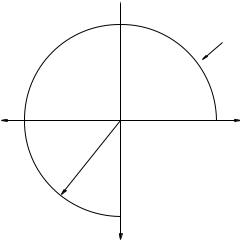
220 |
Week 4: Systems of Particles, Momentum and Collisions |
Homework for Week 4
Problem 1.
Physics Concepts: Make this week’s physics concepts summary as you work all of the problems in this week’s assignment. Be sure to cross-reference each concept in the summary to the problem(s) they were key to, and include concepts from previous weeks as necessary. Do the work carefully enough that you can (after it has been handed in and graded) punch it and add it to a three ring binder for review and study come finals!
Problem 2.
 y
y
M
x
R
This problem will help you learn required concepts such as:
•Center of Mass
•Integrating a Distribution of Mass
so please review them before you begin.
In the figure above, a uniformly thick piece of wire is bent into 3/4 of a circular arc as shown. Find the center of mass of the wire in the coordinate system given, using integration to find the xcm and ycm components separately.
Week 4: Systems of Particles, Momentum and Collisions |
221 |
Problem 3.
Suppose we have a block of mass m sitting initially at rest on a table. A massless string is attached to the block and to a motor that delivers a constant power P to the block as it pulls it in the x-direction.
a)Find the tension T in the string as a function of v, the speed of the block in the x-direction, initially assuming that the table is frictionless.
b)Find the acceleration of the block as a function of v.
c)Solve the equation of motion to find the velocity of the block as a function of time. Show that the result is the same that you would get by evaluating:
Z0 |
P dt = |
2 mvf2 − |
2 mv02 |
||
|
t |
1 |
|
1 |
|
with v0 = 0.
d)Suppose that the table exerts a constant force of kinetic friction on the block in the opposite direction to v, with a coe cient of kinetic friction µk. Find the “terminal velocity” of the system after a very long time has passed. Hint: What is the total power delivered to the block by the motor and friction combined at that time?

222 |
Week 4: Systems of Particles, Momentum and Collisions |
Problem 4. |
|
U(x) |
E1 |
x |
E2 |
E3 |
This problem will help you learn required concepts such as:
•Potential energy/total energy diagrams
•Finding the force from the potential energy
•Identifying turning points and stable/unstable equilibribum points on a graph of the potential energy
•Identifying classically forbidden versus allowed domains of motion (in one dimension) on an energy diagram
so please review them before you begin.
a)On (a large copy of) the diagram above, place a small letter ‘u’ to mark points of unstable equilibrium.
b)Place the letter ‘s’ to mark points of stable equilibrium.
c)On the curve itself, place a few arrows in each distinct region indicating the direction of the force. Try to make the lengths of the arrows proportional in a relative way to the arrow you draw for the largest magnitude force.
d)For the three energies shown, mark the turning points of motion with the letter ‘t’.
e) For energy E2, place |
|
allowed |
to mark out the classically allowed region where the particle |
|||
|
|
|
|
|
||
|
}| { |
|||||
might be found. Placez |
to mark out the classically forbidden region where the particle |
|||||
|{z }
forbidden
can never be found.

Week 4: Systems of Particles, Momentum and Collisions |
223 |
Problem 5.
U(X)
30
20
10
0
-10
-20
-30
0 |
0.5 |
1 |
1.5 |
2 |
X
This problem will help you learn required concepts such as:
•Energy conservation and the use of E = K + U in graphs.
•Finding the force from the potential energy.
•Finding turning points and stable/unstable equilibrium points from algebraic expressions for the potential as well as visualizing the result on a graph.
so please review them before you begin.
An object moves in the force produced by a potential energy function:
U (x) = |
1 |
10 |
|
|
− |
|
|
x12 |
x6 |
||
This is a one-dimensional representation of an actual important physical potential, the LennardJones potential. This one-dimensional “12-6” Lennard-Jones potential models the dipole-induced dipole Van der Waals interaction between two atoms or molecules in a gas, but the “12-10” form can also model hydrogen bonds in physical chemistry. Note well that the force is strongly repulsive inside the E = 0 turning point xt (which one can think of as where the atoms “collide”) but weakly attractive for all x > x0, the position of stable equilibrium.
a)Write an algebraic expression for Fx(x).
b)Find x0, the location of the stable equilibrium distance predicted by this potential.
c)Find U (x0) the binding energy for an object located at this distance.
d)Find xt, the turning point distance for E = 0. This is essentially the sum of the radii of the two atoms (in suitable coordinates – the parameters used in this problem are not intended to
be physical).
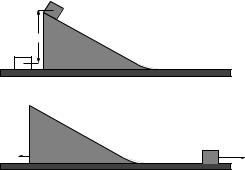
224 |
Week 4: Systems of Particles, Momentum and Collisions |
Problem 6.
(a)m
v = 0 (for both)
H
M
(b)
vM |
M |
vm |
|
|
m |
This problem will help you learn required concepts such as:
•Newton’s Third Law
•Momentum Conservation
•Fully Elastic Collisions
so please review them before you begin.
A small block with mass m is sitting on a large block of mass M that is sloped so that the small block can slide down the larger block. There is no friction between the two blocks, no friction between the large block and the table, and no drag force. The center of mass of the small block is located a height H above where it would be if it were sitting on the table, and both blocks are started at rest (so that the total momentum of this system is zero, note well!)
a)Are there any net external forces acting in this problem? What quantities do you expect to be conserved?
b)Using suitable conservation laws, find the velocities of the two blocks after the small block has slid down the larger one and they have separated.
c)To check your answer, consider the limiting case of M → ∞ (where one rather expects the larger block to pretty much not move). Does your answer to part b) give you the usual result for a block of mass m sliding down from a height H on a fixed incline?
d)This problem doesn’t look like a collision problem, but it easily could be half of one. Look carefully at your answer, and see if you can determine what initial velocity one should give the two blocks so that they would move together and precisely come to rest with the smaller block a height H above the ground. If you put the two halves together, you have solved a fully elastic collision in one dimension in the case where the center of mass velocity is zero!
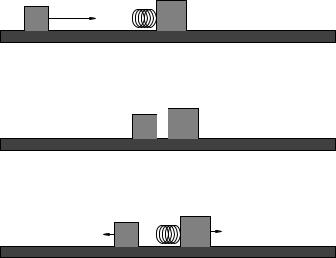
Week 4: Systems of Particles, Momentum and Collisions |
225 |
Problem 7.
(a) |
|
(2 at rest) |
1 |
vo |
2 |
|
vcm
(b)  1
1 
 2
2
(c)
v |
|
|
v |
|
|
2 |
|
1 |
1 |
2 |
|
|
|
This problem will help you learn required concepts such as:
•Newton’s Third Law
•Momentum Conservation
•Energy conservation
•Impulse and average force in a collision
so please review them before you begin.
This problem is intended to walk you through the concepts associated with collisions in one dimension.
In (a) above, mass m1 approaches mass m2 at velocity v0 to the right. Mass m2 is initially at rest. An ideal massless spring with spring constant k is attached to mass m2 and we will assume that it will not be fully compressed from its uncompressed length in this problem.
Begin by considering the forces that act, neglecting friction and drag forces. What will be conserved throughout this problem?
a)In (b) above, mass m1 has collided with mass m2, compressing the spring. At the particular instant shown, both masses are moving with the same velocity to the right. Find this velocity. What physical principle do you use?
b)Also find the compression x of the spring at this instant. What physical principle do you use?
c)The spring has sprung back, pushing the two masses apart. Find the final velocities of the two masses. Note that the diagram assumes that m2 > m1 to guess the final directions, but in general your answer should make sense regardless of their relative mass.
d)So check this. What are the two velocities in the “BB limits” – the m1 m2 (bowling ball strikes ball bearing) and m1 m2 (ball bearing strikes bowling ball) limits? In other words, does your answer make dimensional and intuitive sense?
226 |
Week 4: Systems of Particles, Momentum and Collisions |
e)In this particular problem one could in principle solve Newton’s second law because the elastic collision force is known. In general, of course, it is not known, although for a very sti spring this model is an excellent one to model collisions between hard objects. Assuming that the
spring is su ciently sti that the two masses are in contact for a very short time t, write a simple expression for the impulse imparted to m2 and qualitatively sketch Fav over this time interval compared to Fx(t).
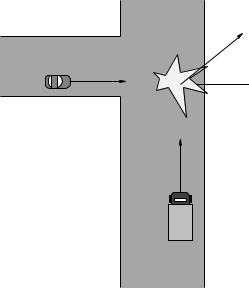
Week 4: Systems of Particles, Momentum and Collisions |
227 |
Problem 8.
vf
vo |
θ |
|
m
vo
M
This problem will help you learn required concepts such as:
•Newton’s Third Law
•Momentum Conservation
•Fully Inelastic Collisions
so please review them before you begin.
In the figure above, a large, heavy truck with mass M speeds through a red light to collide with a small, light compact car of mass m. Both cars fail to brake and are travelling at the speed limit (v0) at the time of the collision, and their metal frames tangle together in the collision so that after the collision they move as one big mass.
a)Which exerts a larger force on the other, the car or the truck?
b)Which transfers a larger momentum to the other, the car or the truck?
c)What is the final velocity of the wreck immediately after the collision (please give (vf , θ))?
d)How much kinetic energy was lost in the collision?
e)If the tires blow and the wreckage has a coe cient of kinetic friction µk with the ground after the collision, set up an expression in terms of vf that will let you solve for how far the wreck slides before coming to a halt. You do not need to substitute your expression from part c) into this and get a final answer, but you should definitely be able to do this on a quiz or exam.

228 |
Week 4: Systems of Particles, Momentum and Collisions |
Problem 9.
xj  xb
xb
xr
m j |
m b |
m r |
|
|
|
|
|
|
|
This problem will help you learn required concepts such as:
•Center of Mass
•Momentum Conservation
•Newton’s Third Law
so please review them before you begin.
Romeo and Juliet are sitting in a boat at rest next to a dock, looking deeply into each other’s eyes. Juliet, overcome with emotion, walks at a constant speed v relative to the water from her end of the boat to sit beside him and give Romeo a kiss. Assume that the masses and initial positions of Romeo, Juliet and the boat are (mr , xr ), (mj , xj ), (mb, xb), where x is measured from the dock as shown, and D = xj − xr is their original distance of separation.
a)While she is moving, the boat and Romeo are moving at speed v′ in the opposite direction. What is the ratio v′/v?
b)What is vrel = dD/dt, their relative speed of approach in terms of v.
c)How far has the boat moved away from the dock when she reaches him?
d)Make sure that your answer makes sense by thinking about the following “BB” limits: mb mr = mj ; mb mr = mj .
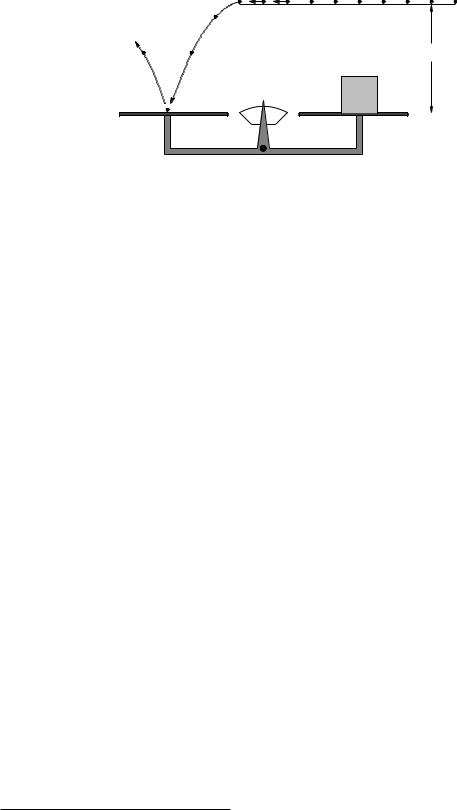
Week 4: Systems of Particles, Momentum and Collisions |
229 |
Problem 10.
m |
H |
M
This problem will help you learn required concepts such as:
•Newton’s Second Law
•Gravitation
•Newton’s Third Law
•Impulse and Average Force
•Fully Elastic Collisions
so please review them before you begin.
In the figure above, a feeder device provides a steady stream of beads of mass m that fall a distance H and bounce elastically o of one of the hard metal pans of a beam balance scale (and then fall somewhere else into a hopper and disappear from our problem). N beads per second come out of the feeder to bounce o of the pan. Our goal is to derive an expression for M , the mass we should put on the other pan to balance the average force exerted by this stream of beads106
a)First, the easy part. The beads come o of the feeder with an initial velocity of ~v = v0xxˆ in the x-direction only. Find the y-component of the velocity vy when a single bead hits the pan after falling a height H.
b)Since the beads bounce elastically, the x-component of their velocity is unchanged and the
y-component reverses. Find the change of the momentum of this bead p~ during its collision.
c)Compute the average force being exerted on the stream of beads by the pan over a second (assuming that N 1, so that many beads strike the pan per second).
d)Use Newton’s Third Law to deduce the average force exerted by the beads on the pan, and from this determine the mass M that would produce the same force on the other pan to keep the scale in balance.
106This is very similar (conceptually) to the way a gas microscopically exerts a force on a surface that confines it; we will later use this idea to understand the pressure exerted by a fluid and to derive the kinetic theory of gases and the ideal gas law P V = N kT , which is why I assign it in particular now.

230 |
Week 4: Systems of Particles, Momentum and Collisions |
Problem 11. |
|
|
R |
|
v |
M |
|
m |
||
|
This problem will help you learn required concepts such as:
•Conservation of Momentum
•Conservation of Energy
•Disposition of energy in fully inelastic collisions
•Circular motion
•The di erent kinds of constraint forces exerted by rigid rods versus strings.
so please review them before you begin.
A block of mass M is attached to a rigid massless rod of length R (pivot to center-of-mass of the block/bullet distance at collision) and is suspended from a frictionless pivot. A bullet of mass m travelling at velocity v strikes it as shown and is quickly stopped by friction in the hole so that the two masses move together as one thereafter. Find:
a)The minimum speed vr that the bullet must have in order to swing through a complete circle after the collision. Note well that the pendulum is attached to a rod!
b)The energy lost in the collision when the bullet is incident at this speed.

Week 4: Systems of Particles, Momentum and Collisions |
231 |
Advanced Problem 12.
λ (x) = 2Mx L2
|
|
|
|
|
|
|
|
|
|
|
|
|
|
|
|
|
|
|
|
|
|
|
|
|
|
|
|
|
|
|
|
|
|
|
|
|
|
|
|
|
|
|
|
|
|
0 |
|
|
|
|
|
|
|
|
|
|
|
|
|
|
|
|
|
|
L |
+x |
||
This problem will help you learn required concepts such as:
•Center of Mass of Continuous Mass Distributions
•Integrating Over Distributions
so please review them before you begin.
In the figure above a rod of total mass M and length L is portrayed that has been machined so that it has a mass per unit length that increases linearly along the length of the rod:
2M λ(x) = L2 x
This might be viewed as a very crude model for the way mass is distributed in something like a baseball bat or tennis racket, with most of the mass near one end of a long object and very little near the other (and a continuum in between).
Treat the rod as if it is really one dimensional (we know that the center of mass will be in the center of the rod as far as y or z are concerned, but the rod is so thin that we can imagine that y ≈ z ≈ 0) and:
a)verify that the total mass of the rod is indeed M for this mass distribution;
b)find xcm, the x-coordinate of the center of mass of the rod.

232 |
Week 4: Systems of Particles, Momentum and Collisions |
Optional Problems
The following problems are not required or to be handed in, but are provided to give you some extra things to work on or test yourself with after mastering the required problems and concepts above and to prepare for quizzes and exams.
Optional Problem 13.
vi k
m
M
vb
vf
(block at rest)
D
This problem will help you learn required concepts such as:
•Momentum Conservation
•The Impact Approximation
•Elastic versus Inelastic Collisions
•The Non-conservative Work-Mechanical Energy Theorem
so please review them before you begin.
In the figure above a bullet of mass m is travelling at initial speed vi to the right when it strikes a larger block of mass M that is resting on a rough horizontal table (with coe cient of friction between block and table of µk). Instead of “sticking” in the block, the bullet blasts its way through the block (without changing the mass of the block significantly in the process). It emerges with the smaller speed vf , still to the right.
a)Find the speed of the block vb immediately after the collision (but before the block has had time to slide any significant distance on the rough surface).
b)Find the (kinetic) energy lost during this collision. Where did this energy go?
c)How far down the rough surface D does the block slide before coming to rest?
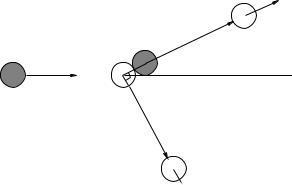
Week 5: Torque and Rotation in One Dimension |
233 |
Optional Problem 14.
vt
|
|
m |
|
|
θu |
m |
vo |
θb |
|
||
|
|
 vb
vb
This problem will help you learn required concepts such as:
•Vector Momentum Conservation
•Fully Elastic Collisions in Two Dimensions
so please review them before you begin.
In the figure above, two identical billiard balls of mass m are sitting in a zero gravity vacuum (so that we can neglect drag forces and gravity). The one on the left is given a push in the x-direction so that it elastically strikes the one on the right (which is at rest) o center at speed v0. The top ball recoils along the direction shown at a speed vt and angle θt relative to the direction of incidence of the bottom ball, which is deflected so that it comes out of the collision at speed vb at angle θb relative to this direction.
a) Use conservation of momentum to show that in this special case that the two masses are equal:
~v0 = ~vu + ~vb
and draw this out as a triangle.
b) Use the fact that the collision was elastic to show that
v02 = vu2 + vb2
(where these speeds are the lengths of the vectors in the triangle you just drew).
c)Identify this equation and triangle with the pythagorean theorem proving that in this case ~vt ~vb (so that
θu = θb + π/2
Using these results, one can actually solve for ~vu and ~vb given only v0 and either of θu or θb. Reasoning very similar to this is used to analyze the results of e.g. nuclear scattering experiments at various laboratories around the world (including Duke)!
234 |
Week 5: Torque and Rotation in One Dimension |
